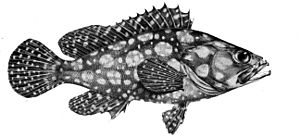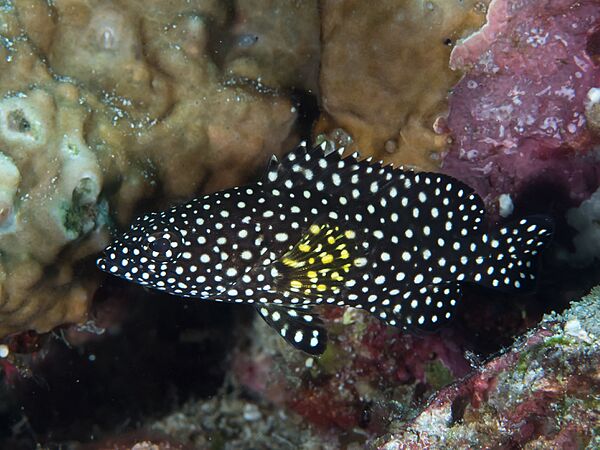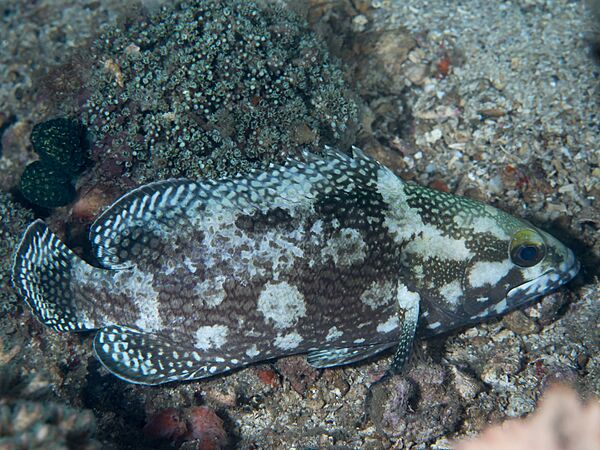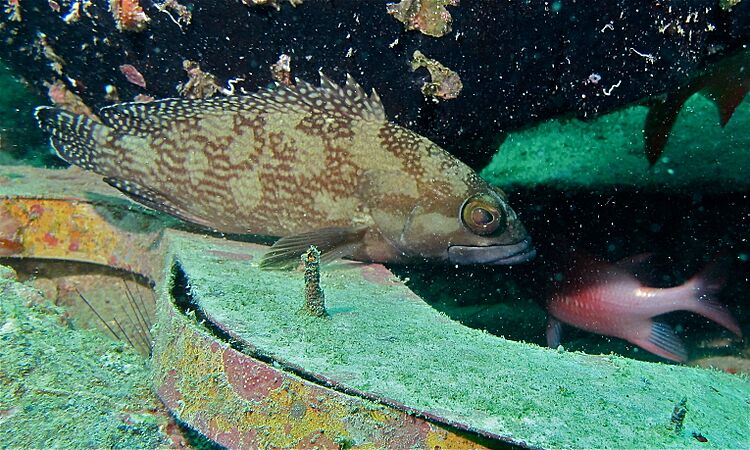White-streaked grouper facts for kids
Quick facts for kids White-streaked grouper |
|
|---|---|
 |
|
| Conservation status | |
| Scientific classification | |
| Synonyms | |
|
The white-streaked grouper (scientific name: Epinephelus ongus) is a type of fish that lives in the ocean. It is also known by other names like specklefin grouper or white-spotted rock-cod. This fish belongs to a group called groupers.
Groupers are part of a larger fish family called Serranidae. This family also includes other fish like anthias and sea basses. The white-streaked grouper lives in a wide area of the Indo-Pacific region. You can find it in both salty ocean waters and slightly salty brackish waters near coasts.
Contents
What Does the White-Streaked Grouper Look Like?
The white-streaked grouper has a body that is about 2.7 to 3.2 times longer than it is deep. Its head is slightly curved on top, and the area between its eyes is flat. The edge of its gill cover is rounded and mostly covered by skin.
This fish has two main fins on its back. The first one has 11 stiff spines. The second one has 14 to 16 soft rays. Its anal fin, located near its tail, has 3 spines and 8 soft rays. The tail fin can be slightly rounded or curved outwards.
The color of this grouper is usually brown. It has large white blotches and many smaller pale spots. These spots are found on its head, body, and fins. In older, larger fish, these spots often stretch out into streaks. The middle fins have a dark band near their edges.
Young white-streaked groupers are dark brown. They have white spots all over their bodies and fins. These spots often form wavy lines. They also have a faint dark streak near their mouth. This fish can grow up to 40 centimeters (about 16 inches) long.
Where Does the White-Streaked Grouper Live?
The white-streaked grouper lives in a large area called the Indo-Pacific. This includes the Indian Ocean and parts of the Pacific Ocean.
You can find it along the east coast of Africa, from Somalia down to South Africa. It also lives near Madagascar, the Seychelles, and the Maldives. It is found off the coasts of southern India, Sri Lanka, Thailand, and Malaysia.
Further east, it lives in the Pacific Ocean. Its range extends to New Caledonia and Tonga. To the north, it reaches the Ryūkyū Islands and Ogasawara Islands in southern Japan. To the south, it is found around Australia. In Australia, it lives near offshore reefs in Western Australia, off Arnhem Land, and on the Great Barrier Reef off Queensland.
Habitat and Life of the White-Streaked Grouper
The white-streaked grouper lives in coastal reefs and lagoons. It can also be found in brackish waters, which are a mix of fresh and salt water. These fish like to hide in ledges and caves. They usually live at depths between 5 and 25 meters (about 16 to 82 feet). Adult fish tend to live in deeper water than younger ones.
This grouper mainly eats crustaceans (like crabs and shrimp) and small fish. Off the coast of Okinawa, Japan, these fish are often seen near branching corals, such as Acropora.
Reproduction and Life Cycle
The white-streaked grouper is thought to be a protogynous hermaphrodite. This means that most fish are born female. Later in their lives, some of them change sex and become male. About half of these fish change sex when they are around 27.2 centimeters (about 10.7 inches) long and about 7 years old.
These groupers are known to gather together to lay their eggs. This is called a spawning aggregation. Off Okinawa, these gatherings happen over sandy or rocky seabeds. They usually occur near a pass between reef areas. Fish travel an average of 5 to 6 kilometers (about 3 to 3.7 miles) to reach these spawning sites.
Like other fish, groupers can have tiny organisms called parasites living on or inside them. Scientists are still learning about the specific parasites that affect the white-streaked grouper.
How the White-Streaked Grouper Was Named
The white-streaked grouper was first officially described in 1790. A German doctor and naturalist named Marcus Elieser Bloch gave it the scientific name Holocentrus ongus. He said it was found in Japan, but scientists now think this was a mistake and it was actually found in Java.
This grouper's closest relative seems to be Epinephelus summana. That fish lives only in the Red Sea, where the white-streaked grouper is not found.
White-Streaked Grouper and Humans
The white-streaked grouper is not a very common fish. However, people do catch it for food in some areas where it lives. Fishermen use different methods to catch it, such as hook and line, gillnets, spears, and traps. It is also part of the live reef fish trade in Southeast Asia, where fish are kept alive and sold for food.
See also
 In Spanish: Epinephelus ongus para niños
In Spanish: Epinephelus ongus para niños





